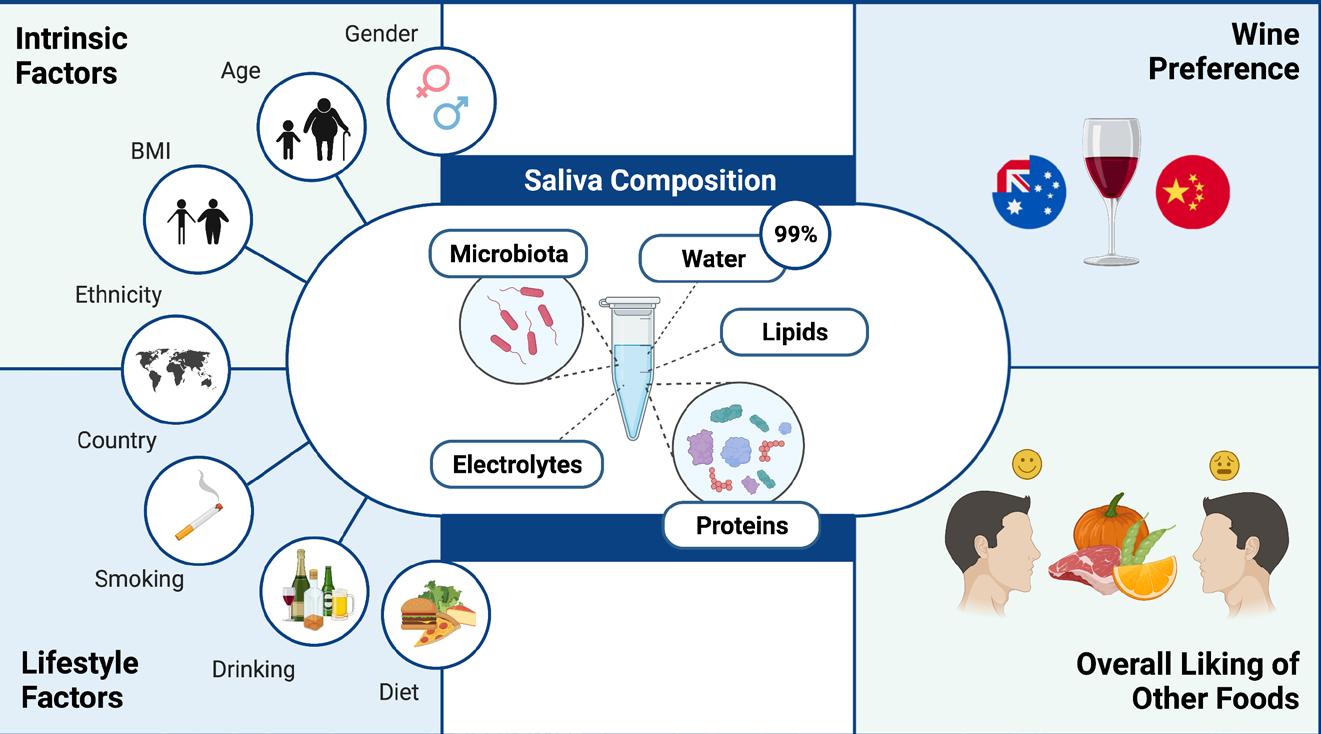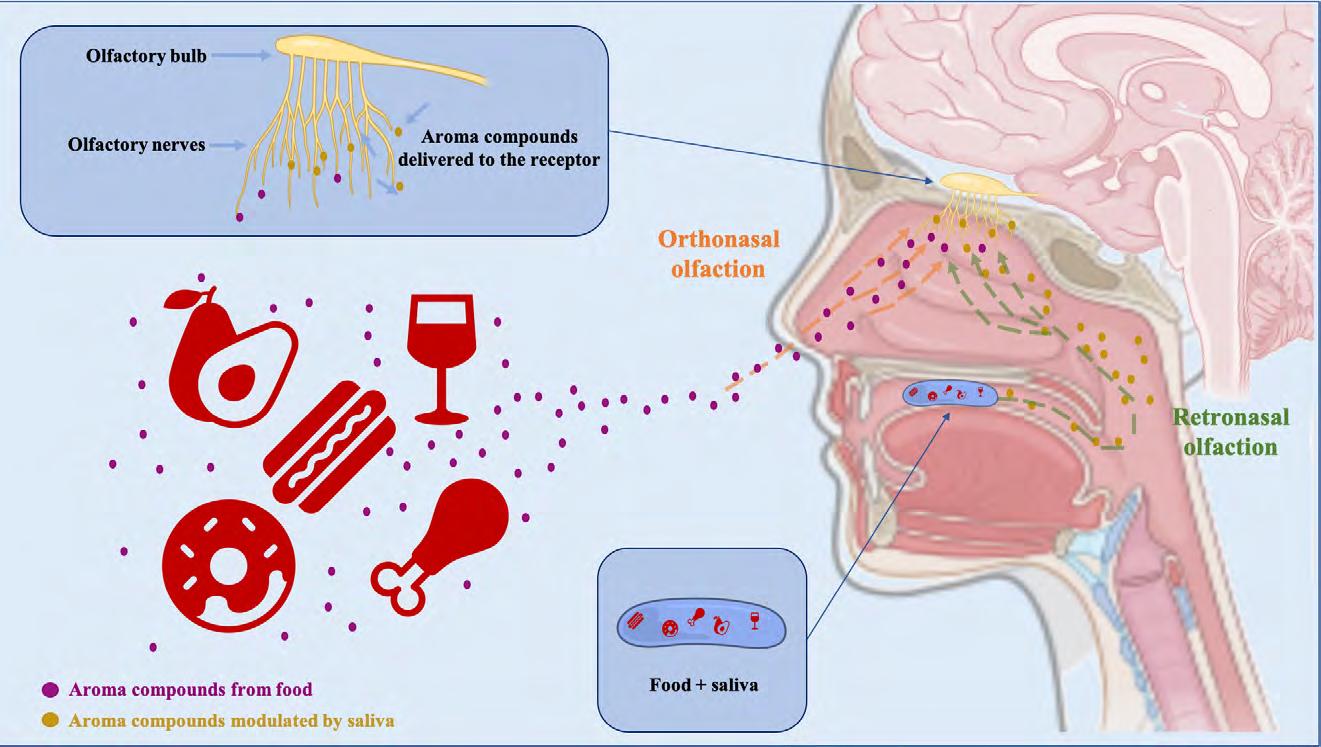
9 minute read
Individual variability of saliva and the perception of food flavour
Words by Xinwei Ruan, Jiaqiang Luo and Dr Kate Howell
Everyone has saliva, which is essential to our physiological processes for digestion, but have you ever wondered what saliva is made of? While human saliva appears similar, its composition between people varies widely.
Variation mainly depends on who you are, your diet and your lifestyle.
Our saliva is integral in every eating process - to reduce food size, initiate digestion and to perceive the flavour of foods. Therefore, is it possible that our individual variation in saliva composition also makes food taste different to different people?
Here, we describe the interindividual variation in human saliva and demonstrate the potential connections to both host factors and sensory perception. Studying various sensory responses potentially allows us to better understand the preferences of consumer groups with diverse salivary compositions and to better design foods for particular audiences.
What is in saliva?
Our saliva is approximately 99% water, but the remaining 1% is highly complex, and includes electrolytes, proteins, lipids, sugars, and hormones.1 The small fraction of functional salivary ingredients provides critical support during food consumption. For example, one of the most common salivary proteins, mucin, has a lubricating and softening effect on food during chewing. Without lubricating proteins like mucin, it is not possible to swallow solid food.
Saliva is important for supporting growth of the oral microbiota and allowing the adhesion of the resident microorganisms. The oral cavity is one of the most complex and clinically relevant habitats in our bodies, colonised by various microbial groups including bacteria, fungi, archaea and viruses. Bacteria are the most abundant microorganisms in saliva as more than 700 bacterial species in the oral cavity have been identified and are supported by saliva as a major energy source.2
Every day, 80 billion bacteria are shed from the surface of the mouth and carried into the digestive tract by swallowing with the help of saliva.3 The salivary microbiome is essential in maintaining host health status through host-microbe interaction. Although the underlying mechanisms by which microbes and host are linked have not been fully understood, emerging evidence shows that the salivary microbiome alters with the changes in health status of the host.
Do we all have the same saliva?
Numerous studies have evidenced the inter-individual variations in our saliva. Different people may vary in both the volume of saliva produced and its composition. Similarly, not all bacteria detected from the oral cavities are shared from person to person.
Our previous study defined the core membership of healthy human salivary microbiota by re-analysing raw 16S rRNA data from 47 studies. Although the core microbiota is common across the 2,206 saliva samples investigated, they also demonstrated large variabilities among different populations.4 Interestingly, the composition of saliva produced by the same person is also dynamic. For example, the composition of our saliva can be significantly different in the morning and the afternoon.
The large variability of salivary composition is attributed to intrinsic personal attributes and lifestyle factors. The intrinsic factors are inherent physiological characteristics such as age, gender, ethnicity, circadian rhythm and genetic characteristics, while lifestyle factors are regarded as extrinsic factors.
Some lifestyle habits, such as smoking, drinking alcohol and
dietary composition may affect the composition of saliva. As a recognised risk factor for oral health, smoking tobacco drastically alters the type and abundance of oral bacteria. Such changes in oral microbial profiles may result in the development of various diseases, such as cancer and diabetes. The alteration may be produced by direct contact between microorganisms in the human mouth and the toxic components in cigarettes.5
How is saliva associated with flavour perception?
The flavour of food is predominantly determined by its volatile profile and the physicochemical composition of the food matrix. When perceiving food aroma we rely on orthonasal and retronasal olfaction (Figure 2). The former happens when we directly sniff the food and aroma compounds reach the olfactory nerves located in the nasal cavity through our nostrils.
When eating, retronasal olfaction allows aroma compounds to travel from the mouth to the nasal cavity and then to the olfactory receptors. Food aroma perceived by the retronasal olfaction varies not only in the intensities of particular notes, but also the types of perceivable sensory attributes due to the modulating effects of the oral environment.
Retronasal olfaction begins when food is taken into the mouth and disrupted with mastication. Mastication increases the release of hydrophobic aroma compounds present in food by interrupting bonding to lipids via weak Van der Waals forces and other hydrophobic binding interactions.
The contribution of saliva to aroma perception is interesting when liquid consumption is considered. Saliva can change the partition coefficient of aroma compounds by dilution, salting out and modification of rheological properties. As the partition coefficient of individual aroma compounds is changed, they become more available to be perceived via retronasal olfaction.
Salivary components are able to participate in olfaction in different ways. Firstly, by the binding of salivary proteins and aroma compounds; secondly, by catalysing enzymatic reactions; and thirdly by oral microbiota directly producing aroma compounds.
If we consider the first, proteins are able to interact with aroma compounds modulating their release and therefore influence retronasal olfaction. The most abundant human salivary proteins, α-amylase and mucin, demonstrate strong aroma retention capacity, typically against esters by the hydrophobic interaction.6
Notably, a trace protein lipocalin-1 is likely to bind small aroma compounds by its hydrophobic pocket structure and then transport these compounds to the olfactory receptors. Results from our work7 also demonstrated that participants with more abundant salivary lipocalin-1 tended to perceive stronger ‘fruity’ and ‘floral’ notes from Shiraz wine.
The second mode of interaction is from enzymes in human saliva participating directly in aroma release. Salivary easters, aldehyde dehydrogenases and peroxidases are accessible to specific substrates present in the food being consumed. They can potentially catalyse chemical reactions to shape in-mouth aroma release and consequently flavour perception.
Finally, there are studies which

Figure 1. Saliva composition is influenced by host factors and contributes to food selection and preference.
Figure 2. Food aroma perception by orthonasal and retronasal olfaction. Orthonasal olfaction is the direct detection of volatile compounds through the nose, which is detected by aroma receptors to then be processed by the olfactory bulb. Retronasal olfaction describes the aroma compounds released by food after mixing with saliva in the mouth.


show that oral microorganisms are themselves able to produce volatile compounds. Production of aromas can be achieved by either their own metabolism, producing malodorous volatile sulfur compounds or hydrolysis of odourless precursors. Muñoz-González et al8 reported that human oral bacteria were capable of releasing grape C6-alcohols, terpenes and benzenoids from their glycosylated precursors and thus impacting the flavour of wine.
Change your lifestyle, change your saliva (and the foods you prefer)
Since saliva composition is related to host factors and it affects aroma perception, we can potentially explain the inter-individual variation in sensory perception by the differences in our saliva induced by our intrinsic or lifestyle factors. This hypothesis has been tested in consumers’ sensory responses to wine.
A study showed that the rate of aroma release from wine is different in the saliva of obese people versus normal-weight people.9 Recently, the effects of age and gender differences on in-mouth volatile release during wine tasting were shown to be related to composition of saliva.10 It is possible that other factors are related to wine perception and preference. Our study found that Western and Chinese wine consumers reported different flavours and aromas in the same wines. Further analysis suggested that significant differences in salivary proteins altered in the Western and Chinese wine consumers and may then in turn affect flavour release and detection to explain this variation.7
Establishing relationships between different consumers and their perceptions of wine could help the wine industry better understand the preferences of different markets and make wines accordingly. Beyond wine, consumers could choose other foods that meet their individual preferences.
Studies have investigated preferences based on saliva composition in other foods, such as cheese, bread and ice cream, but as yet, these predictions exist in the research domain only. Perhaps one day in the future, the moment you step into a supermarket, your smartphone will be able to tell you which foods are right for you, just based on your personal lifestyle, intrinsic factors and the composition of your saliva.
References
1. Dawes, C. et al. (2015). “The functions of human saliva: A review sponsored by the
World Workshop on Oral Medicine VI” Archives of Oral Biology, 60(6): 863-874 https://doi. org/10.1016/j.archoralbio.2015.03.004 2 Welch, J. L. M., Rossetti, B. J., Rieken, C.
W., Dewhirst, F. E. & Borisy, G. G. (2016).
“Biogeography of a human oral microbiome at the micron scale” Proceedings of the National
Academy of Sciences, 113(6): E791-E800 https://doi.org/10.1073/pnas.1522149113 3 Pedersen, A. M. L. & Belstrøm, D. (2019). “The role of natural salivary defences in maintaining a healthy oral microbiota” Journal of
Dentistry, 80: S3-S12 https://doi.org/10.1016/j. jdent.2018.08.010 4 Ruan, X., Luo, J., Zhang, P. & Howell, K. (2022). “The salivary microbiome shows a high prevalence of core bacterial members yet variability across human populations” bioRxiv: 2021.2012.2013.471511 https://doi. org/10.1101/2021.12.13.471511 5 Yu, G. et al. (2017). “The effect of cigarette smoking on the oral and nasal microbiota”
Microbiome, 5(1): 3 https://doi.org/10.1186/ s40168-016-0226-6 6 Pagès-Hélary, S., Andriot, I., Guichard, E. &
Canon, F. (2014). “Retention effect of human saliva on aroma release and respective contribution of salivary mucin and α-amylase”
Food Research International, 64: 424-431 https://doi.org/10.1016/j.foodres.2014.07.013 7 Luo, J. et al. (2021). “Can variation in wine preference amongst consumers be explained by salivary protein composition?”
Poster presented at the Institute of Food
Technologists annual meeting 2020,
Chicago, IL 8 Muñoz-González, C., Cueva, C., Ángeles Pozo-
Bayón, M. & Victoria Moreno-Arribas, M. (2015).
“Ability of human oral microbiota to produce wine odorant aglycones from odourless grape glycosidic aroma precursors” Food
Chemistry, 187: 112-119 https://doi.org/10.1016/j. foodchem.2015.04.068 9 Piombino, P. et al. (2014). “Saliva from
Obese Individuals Suppresses the Release of
Aroma Compounds from Wine” PLOS ONE, 9(1): e85611 https://doi.org/10.1371/journal. pone.0085611 10 Pérez-Jiménez, M. et al. (2022). “Insights on the effect of age and gender on in-mouth volatile release during wine tasting” Food
Research International, 155: 111100 https://doi. org/10.1016/j.foodres.2022.111100
Miss Xinwei Ruan (MSc, UMelb) is a PhD candidate in Agricultural Science at the University of Melbourne. She is working on investigating the inter-individual variation in human salivary microbiota, and the influence of saliva composition on the sensory perception of foods. Follow her @louise_ruan95.
Mr Jiaqiang Luo (MSc, UMelb) is a PhD candidate at the University of Melbourne. He is currently working on understanding the impacts of salivary protein composition on wine sensory perception and preference. He is a cofounder of Nanjing Jizhishi New Material Technology Co., Ltd. and a portrait photographer. Follow him @ xavier_luo.
Associate Professor Kate Howell (PhD, UNSW) is a lecturer and researcher at the University of Melbourne. She heads a laboratory of postdocs and graduate researchers to investigate questions of microbial ecology and chemistry in agriculture and food production. Kate has particular expertise in yeast biology and genetics with applications to food and beverage production. Follow her @ lifeonthefly15 f










